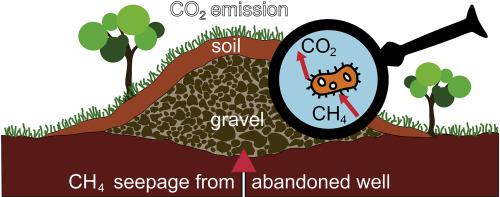当前位置:
X-MOL 学术
›
Appl. Geochem.
›
论文详情
Our official English website, www.x-mol.net, welcomes your
feedback! (Note: you will need to create a separate account there.)
Characterization and microbial mitigation of fugitive methane emissions from oil and gas wells: Example from Indiana, USA
Applied Geochemistry ( IF 3.1 ) Pub Date : 2020-07-01 , DOI: 10.1016/j.apgeochem.2020.104619 Yidong Yin , Maria Mastalerz , Jay T. Lennon , Agnieszka Drobniak , Arndt Schimmelmann
Applied Geochemistry ( IF 3.1 ) Pub Date : 2020-07-01 , DOI: 10.1016/j.apgeochem.2020.104619 Yidong Yin , Maria Mastalerz , Jay T. Lennon , Agnieszka Drobniak , Arndt Schimmelmann

|
Abstract Hydrocarbon gas emissions from active, inactive, and improperly sealed or abandoned oil/gas wells significantly contribute to anthropogenically emitted greenhouse gases, predominantly in the form of methane (CH4). We explored the extent of hydrocarbon gas emissions from 20 active, inactive, plugged and abandoned oil/gas wells in Indiana (USA), where it is estimated that there are more than 80,000 well sites throughout the state. After this initial survey, using a static flux tent, we quantified fugitive CH4 emissions from an active gas well to approximately 2 L h−1. To evaluate the potential for microbial mitigation of hydrocarbon emissions to the atmosphere, we conducted laboratory microcosm experiments to quantify the CH4 oxidizing potential of soils collected from sites with varying distances to the leaking gas well. Soils in close proximity to the well (0.5 m) efficiently consumed nearly all (97%) of the added CH4, while only 14% of added CH4 was consumed by soils that were more distant from the well (20 m). These results suggest that fugitive CH4 emissions enrich methanotrophic bacteria in soils immediately adjacent to the well. Consistent with this view, we found that prolonged exposure of soils to elevated concentrations of CH4 enhanced the methanotrophic activity. Together, these findings prompted us to design a “methanotrophic soil mound” to assess the feasibility of mitigating point sources of CH4 by harnessing the natural methanotrophic capacity of soil microbial communities. We found that a methanotrophic soil mound from a landfill could sustainably mitigate the CH4 emission from the artificial source, providing a promising low-cost solution to ameliorate fugitive CH4 emissions from abandoned oil and gas wells to the atmosphere. The effectiveness of microbe-based remediation is limited in cold climates and arid environments.
中文翻译:

油气井逸散性甲烷排放的表征和微生物缓解:美国印第安纳州的示例
摘要 活跃、不活跃和未正确密封或废弃的油/气井的碳氢化合物气体排放显着增加了人为排放的温室气体,主要以甲烷 (CH4) 的形式排放。我们探索了印第安纳州(美国)的 20 口活跃、不活跃、堵塞和废弃的油气井的碳氢化合物气体排放范围,据估计,该州有 80,000 多个井场。在此初步调查之后,我们使用静态通量帐篷将活性气井的逸散 CH4 排放量化为大约 2 L h-1。为了评估微生物减少碳氢化合物排放到大气中的潜力,我们进行了实验室微观实验,以量化从与泄漏气井距离不同的地点收集的土壤的 CH4 氧化潜力。靠近井 (0.5 m) 的土壤有效地消耗了几乎所有 (97%) 添加的 CH4,而仅 14% 的添加 CH4 被距离井 (20 m) 更远的土壤消耗。这些结果表明,逸散性 CH4 排放丰富了紧邻井的土壤中的甲烷氧化菌。与此观点一致,我们发现土壤长时间暴露于高浓度 CH4 会增强甲烷氧化活性。总之,这些发现促使我们设计了一个“甲烷营养土丘”,以评估通过利用土壤微生物群落的天然甲烷营养能力来减轻 CH4 点源的可行性。我们发现来自垃圾填埋场的甲烷营养土丘可以可持续地减少人工来源的 CH4 排放,提供一种有前景的低成本解决方案,以改善废弃油气井向大气中的无组织 CH4 排放。在寒冷气候和干旱环境中,基于微生物的修复的有效性是有限的。
更新日期:2020-07-01
中文翻译:

油气井逸散性甲烷排放的表征和微生物缓解:美国印第安纳州的示例
摘要 活跃、不活跃和未正确密封或废弃的油/气井的碳氢化合物气体排放显着增加了人为排放的温室气体,主要以甲烷 (CH4) 的形式排放。我们探索了印第安纳州(美国)的 20 口活跃、不活跃、堵塞和废弃的油气井的碳氢化合物气体排放范围,据估计,该州有 80,000 多个井场。在此初步调查之后,我们使用静态通量帐篷将活性气井的逸散 CH4 排放量化为大约 2 L h-1。为了评估微生物减少碳氢化合物排放到大气中的潜力,我们进行了实验室微观实验,以量化从与泄漏气井距离不同的地点收集的土壤的 CH4 氧化潜力。靠近井 (0.5 m) 的土壤有效地消耗了几乎所有 (97%) 添加的 CH4,而仅 14% 的添加 CH4 被距离井 (20 m) 更远的土壤消耗。这些结果表明,逸散性 CH4 排放丰富了紧邻井的土壤中的甲烷氧化菌。与此观点一致,我们发现土壤长时间暴露于高浓度 CH4 会增强甲烷氧化活性。总之,这些发现促使我们设计了一个“甲烷营养土丘”,以评估通过利用土壤微生物群落的天然甲烷营养能力来减轻 CH4 点源的可行性。我们发现来自垃圾填埋场的甲烷营养土丘可以可持续地减少人工来源的 CH4 排放,提供一种有前景的低成本解决方案,以改善废弃油气井向大气中的无组织 CH4 排放。在寒冷气候和干旱环境中,基于微生物的修复的有效性是有限的。











































 京公网安备 11010802027423号
京公网安备 11010802027423号